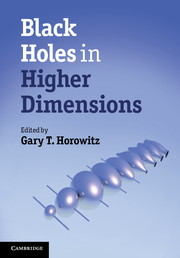Preface
Published online by Cambridge University Press: 05 May 2012
Summary
Black holes are one of the most striking predictions of general relativity. Their main classical properties were understood by the 1970s. In particular, it had been shown that they are very simple objects: stationary vacuum black holes are uniquely characterized by their mass and angular momentum. Astrophysical evidence for black holes has improved dramatically over the past decade and it is now widely accepted that black holes are ubiquitous in our universe.
Naturally enough, the work through the 1970s was focused on black holes in our familiar four spacetime dimensions (D = 4). Recently, there has been an explosion of interest in higher-dimensional black holes. There are at least four reasons for this.
(1)As mentioned above, black holes in D = 4 are special: theymust be spherical, specified by a few parameters, always stable, etc. It is natural to ask whether these properties are characteristic of black holes in general or just a result of four spacetime dimensions.
(2) Recent brane-world ideas suggest that our familiar three spatial dimensions might just be a surface in a higher-dimensional space. In these theories, nongravitational forces are confined to the brane but gravity is higher dimensional. So black holes extend into the extra dimensions.
(3) String theory, one of the most promising approaches to quantum gravity, predicts that spacetime has more than four dimensions. This incorporates older ideas of unification based on the idea that extra dimensions are curled up into a small ball. So, in string theory we must consider higher-dimensional black holes.
- Type
- Chapter
- Information
- Black Holes in Higher Dimensions , pp. xi - xivPublisher: Cambridge University PressPrint publication year: 2012

